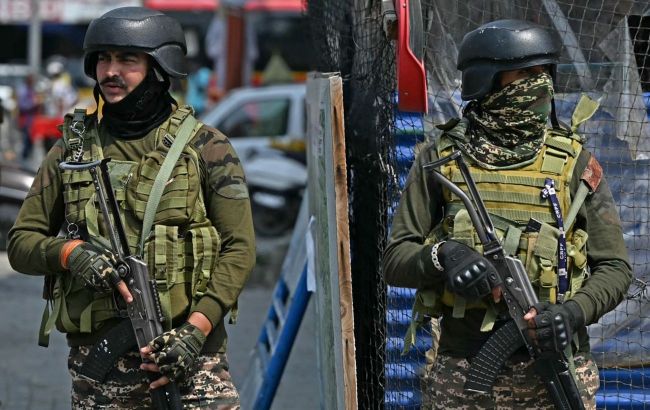Cross-border attacks: Is a nuclear war between India and Pakistan imminent?
 Military on the India-Pakistan border (photo: Getty Images)
Military on the India-Pakistan border (photo: Getty Images)
The escalation between India and Pakistan has reached its peak. The two countries have exchanged strikes and belligerent statements toward each other, making further clashes almost inevitable.
Read RBC-Ukraine's report on whether the current events could escalate into a full-scale war between the two nuclear-armed states.
Takeaways
-
In what ways is the current standoff between India and Pakistan similar to, and different from, past conflicts?
-
Could a real nuclear war break out between the two countries, and when might tensions begin to ease?
-
Why is this current conflict between two nuclear-armed states unlikely to be the last?
How the current conflict began
In the early hours of Wednesday, May 7, India and Pakistan exchanged strikes on each other’s territory. These events marked the culmination of rising tensions between the two countries, triggered by a terrorist attack on April 22. At that time, armed militants killed 26 tourists at a resort near the town of Pahalgam in the Indian-controlled part of the disputed Kashmir region. The attackers deliberately targeted Hindu victims.
A little-known group called the Resistance Front initially claimed responsibility for the attack but later withdrew its statement. India has yet to present substantial evidence of Pakistan's involvement, but it has accused the country’s authorities of being complicit in the attack.
During the Sindoor Operation, at least 26 civilians were killed and 46 others injured on Pakistani territory. Indian authorities claim they targeted militant training camps. However, Pakistan insists the strikes hit "exclusively civilian" areas. According to Pakistani military spokesman Ahmed Sharif Chaudhry, two mosques were among the damaged sites.
In retaliation, Pakistan struck what it claimed was an Indian Army brigade headquarters and a post along the Line of Control in Kashmir. Still, Pakistan’s Defense Minister Khawaja Asif stated that"Islamabad is ready to "wrap up" military actions against India if "New Delhi steps back."
Repeat of 2019?
This is far from the first such escalation between India and Pakistan in recent years. In 2019, events followed a similar, though not identical, pattern. Back then, a car packed with explosives rammed into a bus carrying Indian police officers, killing 40 people. In response, India carried out an airstrike on what it claimed was a militant camp in Pakistan, which led to a series of clashes.
"Back then, India responded only after 12–13 days. They attacked Pakistani territory as well, explaining that they were targeting terrorist gatherings. So now the media drew parallels, suggesting that India would wait, choose its targets carefully, and eventually strike. And this latest attack was to be expected," Nataliia Butyrska, a foreign policy expert specializing in Asia, told RBC-Ukraine.
However, this year’s events differ in some respects. In 2019, the Indian Air Force operated partly in Pakistan’s Khyber Pakhtunkhwa province and mostly in the disputed Kashmir region. This time, the strikes are reportedly more extensive and directed at internationally recognized Pakistani territory — in cities such as Kotli, Bahawalpur, Muridke, Bagh, and Muzaffarabad, mostly in Punjab province.
The night-time strikes triggered a wave of patriotic fervor in Indian political circles and media. Meanwhile, the mood in Pakistan appears more restrained. The country’s leadership is publicly projecting maximum composure. Nevertheless, the likelihood of the current events escalating into a larger-scale conflict remains low.
"India had to respond to public demands after the terrorist attack. Pakistan, in turn, had to retaliate to show it wouldn’t back down. But neither side is interested in a large-scale military conflict," Butyrska explained.
According to her, there’s no serious talk of a nuclear conflict. While some radical Pakistani politicians have made such statements, both sides are generally aware of the consequences of such a confrontation.
"Diplomatic channels, including back-channel communications, remain open, and historical precedents show both sides can de-escalate after limited actions," said Alex Plitsas, an expert with the Atlantic Council.
Still, another limited Pakistani strike on Indian territory, driven purely by reputational motives, cannot be ruled out.
Stabilizing factors
One of the key reasons the current conflict remains limited in scope is the broader international context. In its standoff with India, the comparatively weaker Pakistan has secured support from several powerful states.
Foremost among them is China, which maintains a strategic alliance with Pakistan. For Beijing, Pakistan serves primarily as a critical logistical corridor, linking China’s inland provinces with the global ocean via the China-Pakistan Economic Corridor (CPEC). The two nations also cooperate closely in the field of security.
Importantly, China is a permanent member of the UN Security Council with veto power. Pakistan, for its part, currently holds a non-permanent seat on the Council. Following the latest exchange of strikes, China urged both sides to “avoid actions that could lead to escalation.”
Pakistan also retains longstanding ties with the Gulf monarchies. In recent years, it has leaned more heavily on an alliance with Türkiye and Azerbaijan, established in 2021. Amid the current escalation, Islamabad has received not only political backing from these partners but also likely military support. According to data from Flightradar, six Turkish C-130 Hercules military transport planes recently landed in Pakistan, likely delivering military supplies.
On the other hand, India is not in an ideal position to launch a full-scale war. While it may count on support from some European countries and the United States, which see India as a strategic counterweight to China, several limitations apply. US President Donald Trump, who is seeking re-election, is particularly uninterested in new military conflicts. He has repeatedly stated his intention to “end wars, not start them.” Moreover, India remains entangled in tense relations with China and another Muslim-majority neighbor, Bangladesh.
A further deterrent is Pakistan’s military capability, which could inflict significant losses on India. On the night of May 7, the Pakistani government claimed to have shot down two enemy aircraft and one drone. India denied this, but social media soon circulated photos and videos of wreckage with French-language markings, suggesting the aircraft could be Rafale or Mirage-2000 jets, both used by the Indian Air Force.

Debris of the downed Indian aircraft (photo: Getty Images)
Another powerful deterrent is the presence of nuclear weapons in both countries. While India surpasses Pakistan in overall military strength, there is a balance between the two when it comes to nuclear capabilities. Pakistan does not have an official nuclear doctrine, but it reserves the right to a nuclear response if India launches a non-nuclear attack.
Preconditions for further conflict
Even if the current escalation subsides, the conditions for similar situations to recur remain. The legacy of three full-scale wars cannot simply disappear.
"There is no trust between India and Pakistan, but there is a high level of confrontation that has persisted for years. We also don’t see any prospects for resolving this conflict in such a way that would prevent similar situations from arising in the future — and that always carries the risk of things spiraling out of control," Butyrska told RBC-Ukraine.
To a large extent, the situation will be influenced by how the water issue is resolved. Following the April 23 terrorist attack, India suspended its water treaty with Pakistan regarding the Indus River.
This river flows through Pakistan and is a vital source of drinking water for both the population and industry. However, its headwaters are controlled by India.
"This is another foundation for future disputes. Even if they are satisfied with the current strikes and reach an understanding, the water issue will remain between the two countries," Butyrska emphasized.
Since the beginning of May, dam closures have begun, but this process is likely to be prolonged. This, in turn, creates room for negotiations — but to what extent both sides are currently willing to engage in talks remains an open question. It is quite likely that after a peak in bilateral tensions lasting a week or two, accompanied by limited-scale hostilities, a process of de-escalation will gradually begin.
Sources: materials from The Hindu, The Dawn, and the Atlantic Council, as well as an exclusive commentary from Nataliia Butyrska, a master's degree holder in foreign policy and an expert on Asian affairs.

